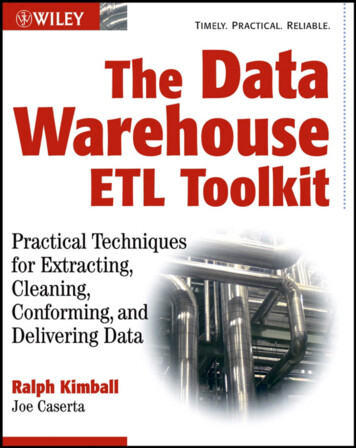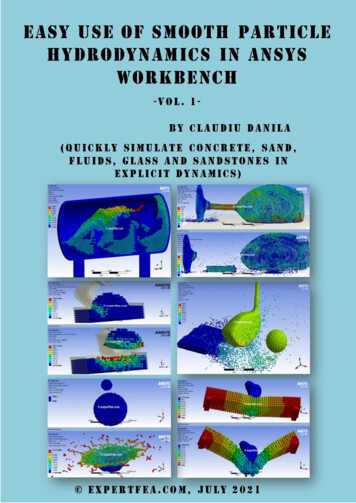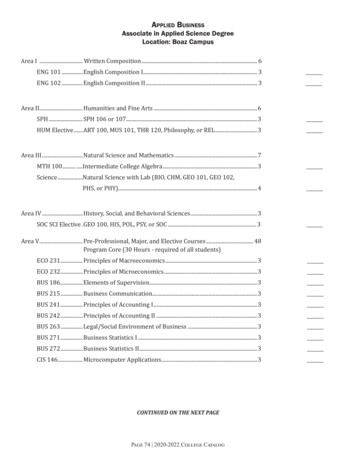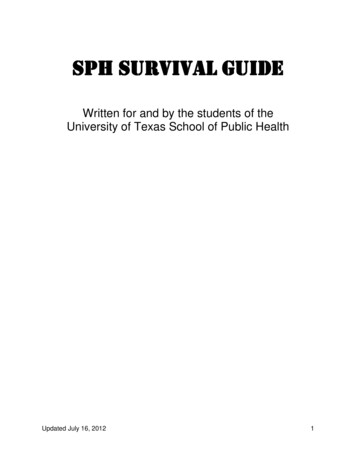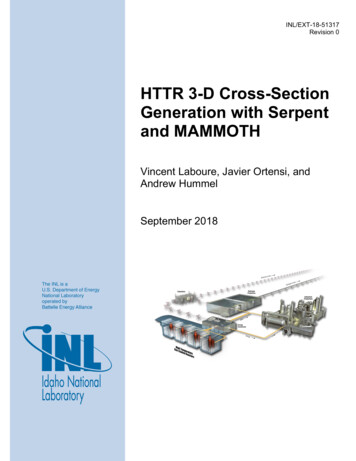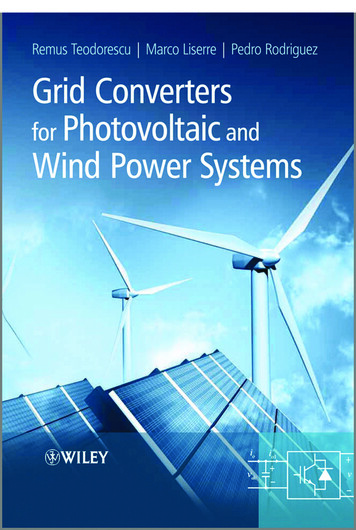
Transcription
P1: OTE/OTE/SPHP2: OTEFMBLBK295-TeodorescuNovember 12, 201013:29Printer Name: Yet to Come
P1: OTE/OTE/SPHP2: OTEFMBLBK295-TeodorescuNovember 18, 201019:43Printer Name: Yet to ComeGRID CONVERTERS FORPHOTOVOLTAIC ANDWIND POWER SYSTEMS
P1: OTE/OTE/SPHP2: OTEFMBLBK295-TeodorescuNovember 18, 201019:43Printer Name: Yet to Come
P1: OTE/OTE/SPHP2: OTEFMBLBK295-TeodorescuNovember 18, 201019:43Printer Name: Yet to ComeGRID CONVERTERS FORPHOTOVOLTAIC ANDWIND POWER SYSTEMSRemus TeodorescuAalborg University, DenmarkMarco LiserrePolitecnico di Bari, ItalyPedro Rodrı́guezTechnical University of Catalonia, SpainA John Wiley and Sons, Ltd., Publication
P1: OTE/OTE/SPHP2: OTEFMBLBK295-TeodorescuNovember 18, 201019:43Printer Name: Yet to ComeThis edition first published 2011 C 2011, John Wiley & Sons, LtdRegistered officeJohn Wiley & Sons, Ltd, The Atrium, Southern Gate, Chichester, West Sussex, PO19 8SQ, United KingdomFor details of our global editorial offices, for customer services and for information about how to apply for permission toreuse the copyright material in this book please see our website at www.wiley.com.The right of the author to be identified as the author of this work has been asserted in accordance with the Copyright,Designs and Patents Act 1988.All rights reserved. No part of this publication may be reproduced, stored in a retrieval system, or transmitted, in any formor by any means, electronic, mechanical, photocopying, recording or otherwise, except as permitted by the UK Copyright,Designs and Patents Act 1988, without the prior permission of the publisher.Wiley also publishes its books in a variety of electronic formats. Some content that appears in print may not be available inelectronic books.Designations used by companies to distinguish their products are often claimed as trademarks. All brand names andproduct names used in this book are trade names, service marks, trademarks or registered trademarks of their respectiveowners. The publisher is not associated with any product or vendor mentioned in this book. This publication is designed toprovide accurate and authoritative information in regard to the subject matter covered. It is sold on the understanding thatthe publisher is not engaged in rendering professional services. If professional advice or other expert assistance is required,the services of a competent professional should be sought.Ris a trademark of The MathWorks, Inc., and is used with permission. The MathWorks does not warrant theMATLAB Rsoftware or related productsaccuracy of the text or exercises in this book. This book’s use or discussion of MATLAB does not constitute endorsement or sponsorship by The MathWorks of a particular pedagogical approach or particular useRsoftware.of MATLAB Library of Congress Cataloguing-in-Publication DataTeodorescu, Remus.Grid converters for photovoltaic and wind power systems / Remus Teodorescu, Marco Liserre, Pedro Rodrı́guez.p. cm.Includes bibliographical references and index.ISBN 978-0-470-05751-3 (hardback)1. Electric current converters. 2. Photovoltaic power systems–Equipment and supplies. 3. Wind energy conversionsystems–Equipment and supplies. I. Liserre, Marco. II. Rodrı́guez, Pedro. III. Title.TK7872.C8T46 2011621.31 244–dc222010031106A catalogue record for this book is available from the British Library.Print ISBN: 9780470057513E-PDF ISBN: 9780470667040O-book ISBN: 9780470667057Set in in 10/12pt Times by Aptara Inc., New Delhi, India
P1: OTE/OTE/SPHP2: OTEFMBLBK295-TeodorescuNovember 18, 201014:22Printer Name: Yet to ComeContentsAbout the 2.42.52.62.7IntroductionWind Power DevelopmentPhotovoltaic Power DevelopmentThe Grid Converter – The Key Element in Grid Integrationof WT and PV SystemsReferencesPhotovoltaic Inverter StructuresIntroductionInverter Structures Derived from H-Bridge Topology2.2.1Basic Full-Bridge Inverter2.2.2H5 Inverter (SMA)2.2.3HERIC Inverter (Sunways)2.2.4REFU Inverter2.2.5Full-Bridge Inverter with DC Bypass – FB-DCBP (Ingeteam)2.2.6Full-Bridge Zero Voltage Rectifier – FB-ZVR2.2.7Summary of H-Bridge Derived TopologiesInverter Structures Derived from NPC Topology2.3.1Neutral Point Clamped (NPC) Half-Bridge Inverter2.3.2Conergy NPC Inverter2.3.3Summary of NPC-Derived Inverter TopologiesTypical PV Inverter Structures2.4.1H-Bridge Based Boosting PV Inverter with High-FrequencyTransformerThree-Phase PV InvertersControl StructuresConclusions and Future 12325252526272829
P1: OTE/OTE/SPHP2: OTEFMBLBK295-TeodorescuNovember 18, 201014:22Printer Name: Yet to 15.2ContentsGrid Requirements for PVIntroductionInternational Regulations3.2.1IEEE 1547 Interconnection of Distributed Generation3.2.2IEC 61727 Characteristics of Utility Interface3.2.3VDE 0126-1-1 Safety3.2.4IEC 61000 Electromagnetic Compatibility (EMC – low frequency)3.2.5EN 50160 Public Distribution Voltage QualityResponse to Abnormal Grid Conditions3.3.1Voltage Deviations3.3.2Frequency Deviations3.3.3Reconnection after TripPower Quality3.4.1DC Current Injection3.4.2Current Harmonics3.4.3Average Power FactorAnti-islanding Requirements3.5.1AI Defined by IEEE 1547/UL 17413.5.2AI Defined by IEC 621163.5.3AI Defined by VDE 7373738383940404141Grid Synchronization in Single-Phase Power ConvertersIntroductionGrid Synchronization Techniques for Single-Phase Systems4.2.1Grid Synchronization Using the Fourier Analysis4.2.2Grid Synchronization Using a Phase-Locked LoopPhase Detection Based on In-Quadrature SignalsSome PLLs Based on In-Quadrature Signal Generation4.4.1PLL Based on a T/4 Transport Delay4.4.2PLL Based on the Hilbert Transform4.4.3PLL Based on the Inverse Park TransformSome PLLs Based on Adaptive Filtering4.5.1The Enhanced PLL4.5.2Second-Order Adaptive Filter4.5.3Second-Order Generalized Integrator4.5.4The SOGI-PLLThe SOGI Frequency-Locked Loop4.6.1Analysis of the 2747880828989Islanding DetectionIntroductionNondetection Zone939394
P1: OTE/OTE/SPHP2: OTEFMBLBK295-TeodorescuNovember 18, 201014:22Printer Name: Yet to 7.47.5viiOverview of Islanding Detection MethodsPassive Islanding Detection Methods5.4.1OUF–OUV Detection5.4.2Phase Jump Detection (PJD)5.4.3Harmonic Detection (HD)5.4.4Passive Method EvaluationActive Islanding Detection Methods5.5.1Frequency Drift Methods5.5.2Voltage Drift Methods5.5.3Grid Impedance Estimation5.5.4PLL-Based Islanding Detention5.5.5Comparison of Active Islanding Detection 14119121121Grid Converter Structures for Wind Turbine SystemsIntroductionWTS Power ConfigurationsGrid Power Converter Topologies6.3.1Single-Cell (VSC or CSC)6.3.2Multicell (Interleaved or Cascaded)WTS Control6.4.1Generator-Side Control6.4.2WTS Grid 9142142Grid Requirements for WT SystemsIntroductionGrid Code 7.2.5Ireland7.2.6US7.2.7China7.2.8SummaryFrequency and Voltage Deviation under Normal OperationActive Power Control in Normal Operation7.4.1Power Curtailment7.4.2Frequency ControlReactive Power Control in Normal 46148148149149150150150151151152153154155155157157
P1: OTE/OTE/SPHP2: OTEFMBLBK295-TeodorescuNovember 18, 201014:22Printer Name: Yet to ontents7.5.4UK7.5.5Ireland7.5.6USBehaviour under Grid ussion of Harmonization of Grid CodesFuture Trends7.8.1Local Voltage Control7.8.2Inertia Emulation (IE)7.8.3Power Oscillation Dumping 65165166166167Grid Synchronization in Three-Phase Power ConvertersIntroductionThe Three-Phase Voltage Vector under Grid Faults8.2.1Unbalanced Grid Voltages during a Grid Fault8.2.2Transient Grid Faults, the Voltage Sags (Dips)8.2.3Propagation of Voltage SagsThe Synchronous Reference Frame PLL under Unbalanced and DistortedGrid ConditionsThe Decoupled Double Synchronous ReferenceFrame PLL (DDSRF-PLL)8.4.1The Double Synchronous Reference Frame8.4.2The Decoupling Network8.4.3Analysis of the DDSRF8.4.4Structure and Response of the DDSRF-PLLThe Double Second-Order Generalized Integrator FLL (DSOGI-FLL)8.5.1Structure of the DSOGI8.5.2Relationship between the DSOGI and the DDSRF8.5.3The FLL for the DSOGI8.5.4Response of the DSOGI-FLLSummaryReferences169169171175177179Grid Converter Control for WTSIntroductionModel of the Converter9.2.1Mathematical Model of the L-Filter Inverter9.2.2Mathematical Model of the LCL-Filter InverterAC Voltage and DC Voltage Control9.3.1Management of the DC Link Voltage9.3.2Cascaded Control of the DC Voltage through the AC 94197198200200201203
P1: OTE/OTE/SPHP2: OTEFMBLBK295-TeodorescuNovember 18, 201014:22Printer Name: Yet to 1.111.211.311.411.5ix9.3.3Tuning Procedure of the PI Controller9.3.4PI-Based Voltage Control Design ExampleVoltage Oriented Control and Direct Power Control9.4.1Synchronous Frame VOC: PQ Open-Loop Control9.4.2Synchronous Frame VOC: PQ Closed-Loop Control9.4.3Stationary Frame VOC: PQ Open-Loop Control9.4.4Stationary Frame VOC: PQ Closed-Loop Control9.4.5Virtual-Flux-Based Control9.4.6Direct Power ControlStand-alone, Micro-grid, Droop Control and Grid Supporting9.5.1Grid-Connected/Stand-Alone Operation without Load Sharing9.5.2Micro-Grid Operation with Controlled Storage9.5.3Droop 6228229229231234235Control of Grid Converters under Grid FaultsIntroductionOverview of Control Techniques for Grid-Connected Converters underUnbalanced Grid Voltage ConditionsControl Structures for Unbalanced Current Injection10.3.1Decoupled Double Synchronous Reference Frame CurrentControllers for Unbalanced Current Injection10.3.2Resonant Controllers for Unbalanced Current InjectionPower Control under Unbalanced Grid Conditions10.4.1Instantaneous Active–Reactive Control (IARC)10.4.2Positive- and Negative-Sequence Control (PNSC)10.4.3Average Active–Reactive Control (AARC)10.4.4Balanced Positive-Sequence Control (BPSC)10.4.5Performance of the IARC, PNSC, AARC and BPSC Strategies10.4.6Flexible Positive- and Negative-Sequence Control (FPNSC)Flexible Power Control with Current Limitation10.5.1Locus of the Current Vector under Unbalanced Grid Conditions10.5.2Instantaneous Value of the Three-Phase Currents10.5.3Estimation of the Maximum Current in Each Phase10.5.4Estimation of the Maximum Active and Reactive Power Set-Point10.5.5Performance of the 64267269270272274277279285285Grid Filter DesignIntroductionFilter TopologiesDesign ConsiderationsPractical Examples of LCL Filters and Grid InteractionsResonance Problem and Damping Solutions289289290291296300238244
P1: OTE/OTE/SPHP2: OTEFMBLBK295-TeodorescuNovember 18, 201014:22Printer Name: Yet to s11.5.1Instability of the Undamped Current Control Loop11.5.2Passive Damping of the Current Control Loop11.5.3Active Damping of the Current Control LoopNonlinear Behaviour of the FilterSummaryReferences300302304306311311Grid Current ControlIntroductionCurrent Harmonic RequirementsLinear Current Control with Separated Modulation12.3.1Use of Averaging12.3.2PI-Based Control12.3.3Deadbeat Control12.3.4Resonant Control12.3.5Harmonic CompensationModulation 3Multilevel Modulations12.4.4Interleaved ModulationOperating Limits of the Current-Controlled ConverterPractical 9335338340343347347350353353Appendix ASpace Vector Transformations of Three-Phase SystemsA.1IntroductionA.2Symmetrical Components in the Frequency DomainA.3Symmetrical Components in the Time DomainA.4Components αβ0 on the Stationary Reference FrameA.5Components dq0 on the Synchronous Reference FrameReferences355355355357359361362Appendix BInstantaneous Power TheoriesB.1IntroductionB.2Origin of Power Definitions at the Time Domain forSingle-Phase SystemsB.3Origin of Active Currents in Multiphase SystemsB.4Instantaneous Calculation of Power Currents inMultiphase SystemsB.5The p-q TheoryB.6Generalization of the p-q Theory to Arbitrary Multiphase SystemsB.7The Modified p-q TheoryB.8Generalized Instantaneous Reactive Power Theory for Three-PhasePower Systems363363365366369371373374376
P1: OTE/OTE/SPHP2: OTEFMBLBK295-TeodorescuNovember 18, 201014:22Printer Name: Yet to ComeContentsB.9xiSummaryReferences377378Appendix CResonant ControllerC.1IntroductionC.2Internal Model PrincipleC.3Equivalence of the PI Controller in the dq Frame and the P ResonantController in the αβ Frame381381381Index385382
P1: OTE/OTE/SPHP2: OTEFMBLBK295-TeodorescuNovember 18, 201014:22Printer Name: Yet to Come
P1: OTE/OTE/SPHP2: OTEFMBLBK295-TeodorescuNovember 18, 201014:22Printer Name: Yet to ComeAbout the AuthorsRemus Teodorescu received a Dipl.Ing. degree from Polytechnical University of Bucharest in 1989, and a PhD degree in power electronics fromUniversity of Galati in 1994. In 1998 he joined Aalborg University, Department of Energy, Power Electronics Section, where he currently works as afull professor.He has more than 150 papers published in IEEE conferences and transactions, one book and four patents (pending). He is the co-recipient of theTechnical Committee Prize Paper Awards at IEEE IAS Annual Meeting1998. He is a Senior Member of IEEE, Past Associate Editor for IEEE Power Electronics Letters and Chair of IEEE Danish Joint IES/PELS/IAS Chapter. His areas of interestsinclude the design and control of grid-connected converters for mainly wind power andphotovoltaic systems and for utility applications FACTS/HVDC. Remus Teodorescu is theco-ordinator of the Vestas Power Programme, a five year research programme involving10 PhD students in the area of power electronics, power systems and storage.Marco Liserre is engaged in teaching courses of power electronics, industrial electronics and electrical machines. His current research interestsinclude industrial electronics applications to distributed power generationsystems based on renewable energies.He has been a visiting Professor at Aalborg University, Denmark, Alcalade Henares University, Spain, and at Christian-Albrechts University of Kiel,Germany. He has given lectures in different universities and tutorials formany conferences. Dr Liserre is an Associate Editor of the IEEE Transactions on Industrial Electronics and IEEE Transactions on Sustainable Energy. He is theFounder and the Editor-in-Chief of the IEEE Industrial Electronics Magazine, 2007–2009. Heis the Founder and the Chairman of the Technical Committee on Renewable Energy Systemsof the IEEE Industrial Electronics Society. He received the IES 2009 Early Career Awardand is IEEE-IES Vice-President for publications. Dr Liserre was the Co-Chairman of theInternational Symposium on Industrial Electronics (ISIE 2010), held in Bari in 2010.
P1: OTE/OTE/SPHP2: OTEFMBLBK295-TeodorescuxivNovember 18, 201014:22Printer Name: Yet to ComeAbout the AuthorsPedro Rodrı́guez received his M.Sc. and Ph.D. degrees in electrical engineering from the Technical University of Catalonia (UPC-BarcelonaTech),Barcelona, Spain. In 1990 he joined the faculty of UPC as an Assistant Professor, where he is currently an Associate Professor in the Department ofElectrical Engineering and the Head of the Research Center on RenewableElectrical Energy Systems (SEER). He was a Visiting Researcher at the Center for Power Electronics Systems, Virginia Polytechnic Institute and StateUniversity, (Blacksburg, USA). He stayed as a Postdoctoral Researcher at theDepartment of Energy Technology (DET), Aalborg University (Denmark).Currently, he is a habitual visiting professor at the DET where he lectures Ph.D. courses andparticipates as a co-supervisor in the Vestas Power Program at the AAU.Pedro Rodrı́guez has coauthored about 100 papers in technical journals and conferenceproceedings. He is the holder of four licensed patents on wind and photovoltaic systems.He has lectured courses on power converters applied to power systems in many universitiesaround the world. His research activity lies in the field of electronic power processors appliedto electrical distributed generation systems, being mainly focused on designing controllers forthe grid interactive power processors, designing power electronics based power processors forgreen energy sources and proposing new technical solutions to improve stability and powerquality in electrical networks. Dr. Rodriguez is a Senior Member of the IEEE, an AssociateEditor of the IEEE Transactions on Power Electronics, and the Chair of the IEEE-IES Studentand GOLD Members Activities Committee.
P1: OTE/OTE/SPHP2: OTEFMBLBK295-TeodorescuNovember 19, 20107:22Printer Name: Yet to ComePrefaceThe penetration of wind- and photovoltaic (PV)-generated electrical energy into the gridsystem worldwide is increasing exponentially. A limiting factor is the increasingly stringentgrid requirements imposed by different grid operators aiming to maintain grid stability. Bothwind power (WP) plants and PV power plants are connected to the grid through grid converterswhich, besides transferring the generated DC power to the AC grid, should now be able toexhibit advanced functions like: dynamic control of active and reactive power; stationaryoperation within a range of voltage and frequency; voltage ride-through; reactive currentinjection during faults; participation in a grid balancing act like primary frequency control,etc. Therefore the aim of this book is to explain the topologies, modulation and control ofgrid converters for both PV and WP applications. In addition to the classical handbooks inpower electronics this book shows the PV- or wind turbine (WT)- specific control functionsaccording to the recent grid codes and enhances the classical synchronization and currentcontrol strategies with the general case when the grid is unbalanced.The idea of this book originated in a biannual Industrial/PhD course ‘Power Electronics forRenewable Energy Systems’ started in May 2005 in Aalborg University, Institute for EnergyTechnology, and is successfully continued with over 250 PhDs or industry engineer attendees(by the end of 2010). The success of this course was due to the practical aspects involved asmore than 40 % of the time was spent in the lab for designing and testing control strategieson real grid converters. Thus, the initiative for writing this book together with Marco Liserrefrom Politecnico di Bari and Pedro Rodrı́guez from UPC Barcelona has been taken in orderto ensure a unique reference for the course.The book is intended as a textbook for graduating students with an electrical engineering background wanting to move into areas of the electrical aspects of PV and WT powerregenerations, as well as for professionals in the PV or WT industry.Chapter 1 gives an overview of the latest developments in the PV and WT penetrations inthe worldwide power systems as well as the forecast until 2014, which looks very promisingdespite the economical crisis of 2008–2010. Chapter 2 discusses the various high-efficiencytopologies for PV inverters as well as some generic control structures. In Chapter 3 the gridrequirements for PV installations are described. Chapter 4 gives a deep analysis of the basicPLL as the preferred tool for synchronization in single-phase systems and discusses differentquadrature signal generator methods, while Chapter 5 discusses islanding detection methods.Chapter 6 describes the most typical WT grid converter topologies together with genericcontrol structures. The most recent grid requirements for WT grid connection, the so-calledGrid Codes, are explained in Chapter 7. The next chapter extrapolates the knowledge of
P1: OTE/OTE/SPHP2: OTEFMBLBK295-TeodorescuxviNovember 18, 201019:43Printer Name: Yet to ComePrefacesingle-phase PLL structure for three-phase systems. New robust synchronization structuresare proposed in order to cope with the unbalance grid or frequency adaptation. In Chapter9 the most used grid converter control structures for WT are explained while Chapter 10extrapolates the control issue for the case of grid faults, where new control structures areproposed. In Chapter 11 the issue of designing grid interface filters is discussed along withmethods actively used to damp the resonance for LCL filters. Finally, Chapter 12 goes downto basics and advanced methods for controlling the grid current going from linear to morerobust nonlinear techniques. The new resonant controllers are introduced and compared withthe classical PI. Appendix A familiarizes the reader with the issue of different coordinatetransformations in three-phase systems, Appendix B gives the basic principle of instantaneouspower theory and Appendix C describes the concept of resonance controllers.www.wiley.com/go/grid converters
P1: OTE/OTE/SPHP2: OTEFMBLBK295-TeodorescuNovember 18, 201014:22Printer Name: Yet to ComeAcknowledgementsThe authors would like to acknowledge the valuable support from the following persons:r Frede Blaabjerg, Professor, Aalborg University, for his general support of this projectr Philip C Kjære, Chief Specialist, Vestas Wind Systems A/S, for his valuable advice andknowledge exchange in the generic field of wind turbine grid integration from a pureindustrial perspectiver Lars Helle, Specialist, power electronics, Vestas Wind Systems A/S, for his support inChapter 7r Tamas Kerekes, Assistant Professor, Aalborg University, for scrutinizing and commentingon Chapter 2r Alvaro Luna, Assistant Professor, UPC Barcelona, for his valuable contribution to Chapters4, 8 and 10r Francesco De Mango, GSE, for his valuable contribution on Chapter 5r Manuel Reyes Diaz, PhD student, University of Seville, for his valuable contribution toChapter 10r Rosa Mastromauro, Assistant Professor, Politecnico di Bari, for his valuable contributionon Chapter 11 and 12r Alberto Pigazo, Assistant Professor, Cantabria University, for his valuable contribution onChapter 5r Ancuta G. Dragomir, MSc student, Aalborg University, for editing most of the figuresr Nicky Skinner, Project Editor, John Wiley & Sons, Ltd, for her patience and trust in thislong project
P1: OTE/OTE/SPHP2: OTEFMBLBK295-TeodorescuNovember 18, 201014:22Printer Name: Yet to Come
P1: OTA/XYZP2: ABCc01BLBK295-TeodorescuOctober 15, 201019:5Printer Name: Yet to Come1IntroductionIn the last few years renewable energies have experienced one of the largest growth areas inpercentage of over 30 % per year, compared with the growth of coal and lignite energy.The goal of the European Community (the EU) is to reach 20 % in 2020, but the EU-27energy is only 17 % of world energy. The US, with 22 % of energy share, has adopted similargoals under the pressure of public opinion concerned by environmental problems and in orderto overcome the economical crisis. However, the policies of Asia and Pacific countries, with35 % of energy share, will probably be more important in the future energy scenario. In fact,countries like China and India require continuously more energy (China energy share hasincreased 1 point every year from 2000).The need for more energy of the emerging countries and the environmental concernsof the US and the EU increases the importance of renewable energy sources in the futureenergy scenario.1.1Wind Power DevelopmentGrid-connected wind systems are being developed very quickly and the penetration of windpower (WP) is increasing.The driving force in Europe was taken in March 2007, when EU Heads of State adopted abinding target of 20 % of energy generated from renewable sources by 2020. A similar planfor 25 % renewable energy sources until 2025 has been adopted in the US.According to BTM Consult [1], the cumulative and annual installed wind power worldwidein 2009 is shown in Figure 1.1. Despite the economic crisis, 2009 was a very good year,with a worldwide installed wind power of 38.1 GW (35 % higher than 2008). The biggestmarkets in 2009 were China, with 36.1 %, and the US, with 26 %. The cumulative worldwideinstalled wind power by the end of 2009 was 160.1 GW. The average growth for the period2004–2009 was 36.1 %, while the forecast average growth for the period 2010–2014 is 13.6 %(reduced due to the economic crisis of 2008–2010). The worldwide cumulative installed powerforecasted by 2019 is close to 1 TW, leading to a global wind power penetration of 8.4 %.Wind energy penetration (%) is defined as the total amount of wind energy producedannually (TWh) divided by the gross annual electricity demand (TWh). According to theGrid Converters for Photovoltaic and Wind Power Systems Remus Teodorescu, Marco Liserre, and Pedro Rodrı́guez C 2011 John Wiley & Sons, Ltd1
P1: OTA/XYZP2: ABCc01BLBK295-TeodorescuOctober 15, 201019:52Printer Name: Yet to ComeGrid Converters for Photovoltaic and Wind Power Systems[MW]Global Cummulative Installed Wind 620072008200920102011201220132014Global Annual Installed Wind 2011201220132014Figure 1.1 Wind power installed worldwide by 2009 and forecast until 2014: cumulative (left) andannual (right). Source: BTM ConsultEWEA (European Wind Energy Association) [2], the approximate wind energy penetrationin Europe by 2008 was 3.8 %, with the highest penetration levels of 21 % in Denmark, 12 %in Spain and Portugal, 9 % in Ireland and 7 % in Germany. At the regional level much higherpenetration levels were achieved, as, for example, 36 % in Schleswig-Holstein, Germany, and70 % in Navarra, Spain.According to the DOE (US Department of Energy) [3], the wind energy penetration levelin the US reached 1.9 % by 2008, with highest state levels in Iowa 13.3 %, Minnesota 10.4 %and Texas 5.3 %. The worldwide wind energy penetration by 2008 was 1.5 %.It is very difficult to define the maximum level of penetration as it is strongly dependent onthe particularities of the grid in the considered area in terms of conventional generation, pricing,interconnection capacity, demand management and eventual storage capacity. Typically severalregional or national grids are interconnected (as, for example, UCTE and NORDEL) and byagreement certain shared reserve generation and transmission capacity is provided in orderto cope with n 1 type contingency. The fluctuating wind power dispatch works also asa ‘disturbance’ in the system and this reserve capacity can also be successfully used forbalancing purposes. Some studies have indicated that 20 % wind penetration may be achievedwithout major transmission or storage developments. Electrical utilities continue to study
P1: OTA/XYZP2: ABCc01BLBK295-TeodorescuOctober 15, 201019:5Printer Name: Yet to ComeIntroduction3Global Cumulative Installed PV 132014Global Annual Installed PV 14Figure 1.2 PV power installed worldwide by 2009 and forecast until 2014: cumulative (left) and annual(right). Source: EPIAthe effects of large-scale (20 % or more) penetration of wind generation on system stabilityand economics. Denmark has planned wind penetration of 50 % by 2025 [4]. The Danishgrid is strongly interconnected to the European electrical grid through Norway, Germany andSweden. Almost half of its wind power is exported to Norway, which can easily balance itsalmost entirely hydro-based power system.In order to be able to increase the wind energy penetration, new grid interconnectionrequirements called grid codes have been developed by countries with high penetration.1.2Photovoltaic Power DevelopmentThe worldwide cumulative and annual photovoltaic (PV) power installed according to EPIAare shown in Figure 1.2 [5].The year 2009 was also a good year for PV, as 6.4 GW was installed (equivalent toapprox one-sixth of wind power installed). From an empirical point of view we can saythat PV is growing at approximately the same rate as WP and is just approximately 6 yearsbehind. The forecast for 2014 is 30 GW for PV, close to the 28.7 GW for WP forcast6 years ago (for 2008). The worldwide cumulative PV power reached 22.8 GW by the endof 2009.
P1: OTA/XYZP2: ABCc01BLBK295-Teodorescu4October 15, 201019:5Printer Name: Yet to ComeGrid Converters for Photovoltaic and Wind Power SystemsToday, there are several PV parks with installed power 40 MW in Spain, Germany andPortugal. The PV penetration is quite low now but it is estimated by EPIA that it could be ashigh as 12 % in 2020.Another important aspect is that the cost of PV panels have dropped during 2008 by around40 % to levels under 2/W for PV. The bulk penetration of the PV system is expected around2015 when the cost of PV electricity is forecasted to became compatible with the cost ofconventional energy.1.3The Grid Converter – The Key Element in Grid Integrationof WT and PV SystemsPower converters is the technology that enables the efficient and flexible interconnectionof different players (renewable energy generation, energy storage, flexible transmission andcontrollable loads) to the electric power system. Hence it is possible to foresee how thesynchronous machine has a central role in the centralized power system and the grid converter,also denoted as the ‘synchronous converter’, will be a major playe
1.1 Wind Power Development 1 1.2 Photovoltaic Power Development 3 1.3 The Grid Converter - The Key Element in Grid Integration of WT and PV Systems 4 References 4 2 Photovoltaic Inverter Structures 5 2.1 Introduction 5 2.2 Inverter Structures Derived from H-Bridge Topology 6 2.2.1 Basic Full-Bridge Inverter 7 2.2.2 H5 Inverter (SMA) 11
